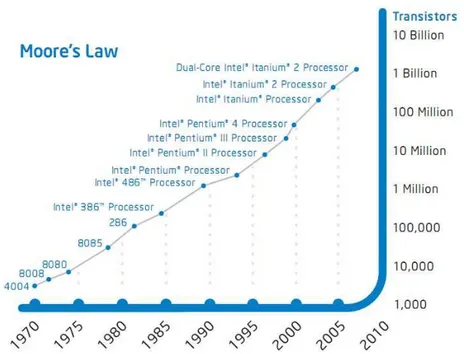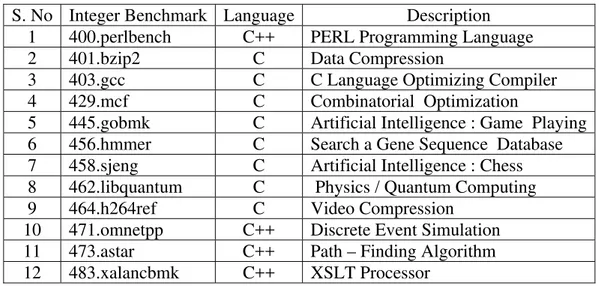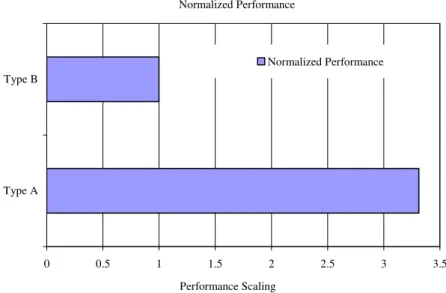Comparison of Processor Performance of SPECint2006 Benchmarks of
some Intel Xeon Processors
Abdul Kareem PARCHUR* and Ram Asaray SINGH
Department of Physics and Electronics, Dr. H. S. Gour University, Sagar, India-470003
E-mail: kareemskpa@hotmail.com
*
Corresponding author: Phone: +91-9907048098
Abstract
High performance is a critical requirement to all microprocessors
manufacturers. The present paper describes the comparison of performance in
two main Intel Xeon series processors (Type A: Intel Xeon X5260, X5460,
E5450 & L5320 and Type B: Intel Xeon X5140, 5130, 5120 & E5310). The
microarchitecture of these processors is implemented using the basis of a new
family of processors from Intel starting with the Pentium 4 processor. These
processors can provide a performance boost for many key application areas in
modern generation. The scaling of performance in two major series of Intel
Xeon processors (Type A: Intel Xeon X5260, X5460, E5450 & L5320 and
Type B: Intel Xeon X5140, 5130, 5120 & E5310) has been analyzed using the
performance numbers of 12 CPU2006 integer benchmarks, performance
numbers that exhibit significant differences in performance. The results and
analysis can be used by performance engineers, scientists and developers to
better understand the performance scaling in modern generation processors.
Keywords
Introduction
The Intel Xeon processor are Intel’s most advanced IA-32 architecture
microprocessor, incorporating a host of new microarchitectural features including a 400MHz
system bus, hyper pipelined technology, advanced dynamic execution, rapid execution
engine, advanced transfer cache, execution trace cache, and Streaming Single Instruction
Multiple Data (SIMD) Extensions 2 (SSE2). The performance of processors is rapidly
changing due to its architecture amendment and deep submicron pipelines. Our earlier studies
reveal the performance scaling, hotspots detection and variation of task completion time in
Intel and AMD processors [1-5]. However, high performance is becomes critical requirement
for all processor manufacturers.
The analysis presented in this paper examines the scaling of performance in different
series of Intel Xeon processors (Type A: Intel Xeon X5260, X5460, E5450 & L5320 and
Type B: Intel Xeon X5140, 5130, 5120 & E5310) which are fabricated for the requirement of
the modern generation utility.
Material and Method
Processor Performance Trends
The performance of modern processors is rapidly increasing as both clock frequency
and the number of transistors required for a given implementation grow. Moore’s Law says
that the device density of the processor double in every 18 months. Figure 1 shows the
transistor count per die of processors introduced by Intel over the past 35 years [6-8]. The
processor that performs a given task in the least amount of time has the highest performance.
Increased performance implies reduced execution time; the performance of the processor is
given by [9]:
Figure 1.Scaling transistors.The number of transistors is expected to continue to double
about every two years, in accordance with Moore's Law. Over time, the number of additional
transistors will allow designers to increase the number of cores per chip. [Source from 10]
The performance of the processor depends on the following factors. Firstly, the
processor performance equation indicates that a processor’s performance is measured in terms
of how long it takes to execute a particular program (time/program). Second, this measure of
time/program or execution time can be formulated as a product of three terms:
instructions/program, cycles/instruction, and time/cycle. The first term indicates the total
number of dynamic instructions that need to be executed for a particular program; this term is
also referred to as instruction count. The second term indicates on average how many
machine cycles are consumed to execute each instruction; typically this term is denoted as the
CPI (cycles per instruction). The third term indicates the length of time of each machine
cycle, namely, the cycle time of the machine.
time cycle CPI
ncount instructio time
execution
Cycle Time n
Instructio Cycles ogram
ons Insttructi ogram
Time e
Performanc = Pr = Pr × ×
1 (2)
Equation 2 is known as Iron Law of processor performance.
different types of benchmarks available. Among all SPEC, HINT, and TPC are most
important and popular benchmarks for performance evolution. SPEC is a non-profit
corporation formed to establish, maintain, and endorse a standardized set of benchmarks.
SPEC’s member-ship includes computer hardware and software vendors, leading universities,
and research facilities worldwide. SPEC CPU2006 is designed to provide a comparative
measure of compute-intensive performance across a range of hardware. Comprised of two
suites of benchmarks, SPEC CPU2006 gauges compute-intensive integer performance with
CINT2006 and measures floating-point performance with CFP2006. CINT2006 and CFP2006
results are presented as ratios, which are calculated using a reference time determined by
SPEC and the runtime of the benchmark higher scores indicate better performance [11].
The SPEC CPU2006 suite contains 18 floating-point programs (Some programs are
written in C and some in FORTRAN) and 13 integer programs (8 written in C, 4 in C++ and 1
in ANSI C). Table 1 and Table 2 provide a list of the benchmarks in SPEC CPU2006 suite.
The SPEC CPU2006 benchmarks replace the SPEC89, SPEC92, SPEC95 and SPEC CPU
2000 benchmarks [12-15].
Table 1. The CINT 2006 Suite Benchmarks
S. No Integer Benchmark Language Description
1 400.perlbench C++ PERL Programming Language
2 401.bzip2 C Data Compression
3 403.gcc C C Language Optimizing Compiler
4 429.mcf C Combinatorial Optimization
5 445.gobmk C Artificial Intelligence : Game Playing
6 456.hmmer C Search a Gene Sequence Database
7 458.sjeng C Artificial Intelligence : Chess
8 462.libquantum C Physics / Quantum Computing
9 464.h264ref C Video Compression
10 471.omnetpp C++ Discrete Event Simulation
11 473.astar C++ Path – Finding Algorithm
12 483.xalancbmk C++ XSLT Processor
Table 2. The CFP2006 Suite Benchmarks
S. No
Floating Point Benchmark
Language Description
1 410.bwaves Fortran – 77 Computational Fluid Dynamics
3 433.milc C Physics / Quantum Chromo Dynamics
4 434.zeusmp Fortran – 77 Physics / Magneto Hydro Dynamics
5 435.gromacs C/Fortran Chemistry / Molecular Dynamics
6 436.cactusADM C / Fortran-90 Physics / General Relativity
7 437.leslie3d Fortran – 90 Computational Fluid Dynamics
8 444.namd C++ Scientific, Structural Biology, Classical
Molecular Dynamics Simulation.
9 447.dealII C++ Solution of Partial Differential Equations
using the Adaptive Finite Element Method.
10 450.soplex C++ Simplex Linear Programming Solver
11 453.povray C++ Computer Visualization / Ray Tracing
12 454.calculix C/Fortran-90 Structural Mechanics
13 459.GemsFDTD Fortran-90 Computational Electromagnetic
14 465.tonto Fortran-95 Quantum Crystallography
15 470.lbm C Computational Fluid Dynamics
16 481.wrf C/Fortran – 90 Weather Processing
17 482.sphinx3 C Speech Recognition
Results and Discussion
In this study we utilize the integer benchmarks from the newly released SPEC
CPU2006 suite [16] for the performance comparison of Intel Xeon processors (Type A: Intel
Xeon X5260, X5460, E5450 & L5320 and Type B: Intel Xeon X5140, 5130, 5120 & E5310)
under the same operating conditions. By using their performance numbers and frequency, we
have calculated Task Completion time, and plotted graphs in between Task Completion Time
(s) and Core Clock (ns) for Type A: Intel Xeon X5260, X5460, E5450 & L5320 and Type B:
Intel Xeon X5140, 5130, 5120 & E5310 Processors. The Scalability and comparison of Intel
Xenon series Processors is shown in figure 2. Extrapolation of the runtime trend lines down to
zero core clock period gives basis for useful interpretation of system behaviour [17].
We have used the “Core Clock Period”, or “Clock Cycle” as the value characterizing
the particular processor speed grade, expressed in nanoseconds (ns). The conversion formula
is very simple: 1000/f [MHz] = clock period [ns]. Processor Performance Equation is
calibrated using the expression:
Y = [Processor time]
= [Processor clock cycles for a program] × [Clock cycle time] = Ax.
(3)
IC) is known, and then dividing this coefficient by IC will give us the well-known
microarchitectural parameter called CPI, “Clocks per Instruction”:
A = [Processor clock cycles for a program] = IC × CPI (4)
The performance of the processor is calculated by using the relation:
Performance = Core Utilization Time % / Memory Wait Time % (5)
The increase in performance of processors in different series of Intel Xeon processors
(Type A: Intel Xeon X5260, X5460, E5450 & L5320 and Type B: Intel Xeon X5140, 5130,
5120 & E5310) was studied by using performance numbers published from SPEC CPU2006
Benchmark suit and results are shown in Figure 2.
Figure 2.The benchmark runtime vs. core clock period shows scaling of performance of Type
A: Intel Xeon X5260, X5460, E5450 & L5320 and Type B: Intel Xeon X5140, 5130, 5120 &
E5310 series processors, Extrapolation of the runtime trendlines down to zero core clock
period gives basis for useful interpretation of system behavior.
The scaling of memory wait time and core time in Type A: Intel Xeon X5260, X5460,
E5450 & L5320 and Type B: Intel Xeon X5140, 5130, 5120 & E5310 Series Processors are
calibrated. It shows that Type A: Intel Xeon X5260, X5460, E5450 & L5320 Series
processors shows maximum performance by showing its least memory wait time, it shows
96.43% core utilize time and 3.573 % memory wait time whereas Type B: Intel Xeon X5140,
wait time on SPECint 2006 Benchmark suit shown in Figure 3.
0 10 20 30 40 50 60 70 80 90 100
Memory Wait Time % Core Time %
Ti
m
e of
Uti
liz
at
ion (
%
)
Type A Type B
Figure 3.The comparison of memory wait time and core utilization time in Type A: Intel
Xeon X5260, X5460, E5450 & L5320 and Type B: Intel Xeon X5140, 5130, 5120 & E5310
series processors.
Performances of the Type A and Type B series processors are compared by
normalizing the performance of Type B Series Processor, which predicts that the performance
of Type A series processors is 3.31 times faster as compared to Type B series processors
(Figure 4). This method is so reliable to compare the performance of the modern processors.
Normalized Performance
0 0.5 1 1.5 2 2.5 3 3.5
Type A Type B
Performance Scaling
Normalized Performance
Contrary to prior work we not only quantify the performance prediction of the
processors, but also evaluate scalability of the Memory Wait Time which degrades the
performance of the processor by using simple statistical correlation techniques [1-5]. This
analysis is more useful to performance engineers, scientists and developers to better
understand how the performance scaling can be exploited in modern generation processors.
Disclaimer
All the observations and analysis done in this paper on SPEC CPU2006int
Benchmarks are the author’s opinions and should not be used as official or unofficial
guidelines from SPEC in selecting benchmarks for any purpose. This paper only provides
guidelines for performance engineers, academic users, scientists and developers to better
understand the performance scaling in modern generation processors and to choose a subset
of benchmarks the need be.
Acknowledgements
The author (Abdul Kareem PARCHUR) gratefully acknowledges financial support of
UGC for a meritorious research fellowship.
References
1. Parchur A.K., Singh R.A., Performance Scaling of Individual SPEC INT 2006 Results for
AMD Processors, Leonardo Electronic Journal of Practices and Technologies, 2009, 8(14)
p.65-72.
2. Parchur A.K., Singh R.A., TCT Analysis of 0.2 ns Core Clock Series Processors, GESJ:
Computer Science and Telecommunications, 2010, 26(3), p. 31-39.
Space by using PCA and CA, Leonardo Electronic Journal of Practices and Technologies,
2010,16, p.43-52.
4. Parchur A.K., Singh R.A., Performance Scaling of Individual SPECint2006 results for
Intel Xeon, e-Journal of Science & Technology, 2009, 4(2), p. 55-60.
5. Parchur A.K., Noorbasha F., Singh R.A., Study the Task completion Time of the
Benchmarks @1GHz, 2GHz and 3GHz Processors, e-Journal of Science & Technology,
2010, 5(2), p.15-22.
6. Tuimi I., The Lives and Death of Moore's Law, First Monday, 2002, Oct 11.
7. www.dell.com/powersolutions [accessed on August-2009].
8. Lilja D.J., Measuring Computer Performance A Practitioner's Guide, Cambridge
University Press, New York, NY, 2000.
9. Understanding Processor Performance, A White paper, August 24, 2001, Online
Available at: http://www.amd.com [accessed on August-2009].
10.From a Few Cores to Many: A Tera-scale Computing Research Review, A White Paper,
Available at: www.intel.com [accessed on August 2009].
11.Henning J.L., SPEC CPU2000: Measuring CPU performance in the new millennium,
IEEE Computer, July 2000, p. 28-35.
12.Standard performance evaluation corporation (SPEC), Benchmarks, http://www.spec.org
[accessed on August-2009].
13.SPEC CPU2000 Press Release FAQ, Available at:
http://www.spec.org/osg/cpu2000/press/faq.html [accessed on August-2009].
14.Osowski A.K., Lilja D., MinneSPEC: A new SPEC benchmark workload for simulation-
based computer architecture research, Computer Architecture Letters, June 2002, p.1-7.
15.Ye D., Ray J., Harle C., Kaeli D., Performance Characterization of SPEC CPU2006
Integer Benchmarks on x86-64 Architecture, IEEE Computer Journal, 2006, p.120-127.
[DOI: 10.1109/IISWC.2006.302736].
16.Standard Performance Evaluation Corporation, SPEC CPU benchmark suite, Available
at: http://www.specbench.org/osg/cpu2006, [accessed on August-2009].
17.Predtechenski A., AMD A Method for Benchmarks Analysis, Online, Available at:



